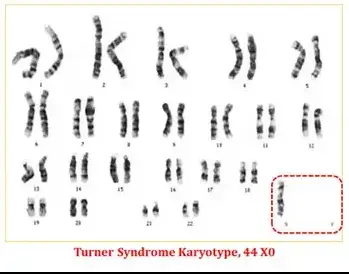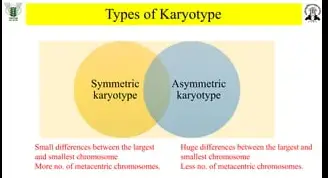Karyotypes are essential tools in genetics for visualizing the chromosome set of an organism, allowing scientists to detect genetic abnormalities and understand chromosomal differences. These differences are generally categorized into symmetric and asymmetric karyotypes, each playing a pivotal role in biological research and medical diagnostics. The distinction between these types can reveal critical insights into genetic health and developmental anomalies.
A symmetric karyotype means that the chromosomes are arranged in a mirror-image or balanced configuration, often indicative of typical genetic stability. In contrast, an asymmetric karyotype features an unbalanced or irregular arrangement, which can be associated with various genetic disorders and abnormalities. This fundamental difference is crucial for proper diagnosis and treatment in genetic medicine.
Chromosome analysis, through the study of symmetric and asymmetric karyotypes, provides invaluable information about the genetic blueprint of an organism. These analyses can help detect hereditary diseases, predict genetic disorders, and even guide treatment options for numerous conditions, highlighting their significance in both research and clinical settings.

Karyotype Basics
Definition and Role
A karyotype is the full complement of chromosomes within a cell, characteristic of an individual organism, its species, or a particular group. Karyotyping is a method used in genetics to study the chromosomal composition of an individual by arranging and photographing the chromosomes under a microscope. This process is essential for identifying genetic abnormalities, diagnosing genetic diseases, and understanding chromosomal changes associated with different stages of life and diseases.
Key Components
The key components of a karyotype include:
- Chromosomes: Structures made of DNA that contain genes.
- Banding Patterns: Unique patterns on each chromosome, used to identify and differentiate them.
- Number and Shape: Human cells, for instance, typically contain 46 chromosomes arranged in 23 pairs, including one pair of sex chromosomes.
Symmetric Karyotypes
Definition and Characteristics
Symmetric karyotypes represent a balanced set of chromosomes where each chromosome has a counterpart with which it pairs perfectly. This symmetry suggests that both sets of homologous chromosomes have the same genes in the same order, which is crucial for normal development and cellular function.
Common Examples
Examples of symmetric karyotypes include:
- Normal Human Karyotype: Comprising 22 pairs of autosomes and one pair of sex chromosomes.
- Diploid Organisms: Such as most plants and animals, which have two sets of chromosomes, one from each parent.
Role in Health
Symmetric karyotypes are typically indicative of genetic stability and health, playing a key role in:
- Normal Development: Ensuring proper growth and function of organisms.
- Disease Prevention: Balanced chromosomes help prevent genetic disorders.
Asymmetric Karyotypes
Definition and Characteristics
An asymmetric karyotype is characterized by an imbalance in chromosome structure or number. This could include extra chromosomes, missing chromosomes, or structurally altered chromosomes that do not pair correctly with their counterparts. Such asymmetry often leads to a disruption in genetic information flow.
Common Examples
Asymmetric karyotypes are found in conditions such as:
- Down Syndrome: Characterized by an extra copy of chromosome 21.
- Klinefelter Syndrome: Typically involving an extra X chromosome in males (XXY).
Implications for Health
The implications of asymmetric karyotypes for health include:
- Developmental Delays: Such as those seen in Down Syndrome.
- Increased Risk of Diseases: Like cancer, where chromosomal instability can lead to malignant transformations.

Comparative Analysis
Symmetry vs. Asymmetry
Comparing symmetric and asymmetric karyotypes sheds light on the balance between genetic stability and genetic variation, crucial for understanding evolutionary and developmental processes. Symmetric karyotypes typically signify a balanced genetic environment, conducive to normal development and cellular functioning. In contrast, asymmetric karyotypes often indicate potential genetic disruptions, which can lead to developmental challenges and health risks.
Genetic Stability and Variation
Genetic stability in symmetric karyotypes contributes to an organism’s ability to function without the interference of genetic abnormalities. However, genetic variation, often seen in asymmetric karyotypes, is essential for evolution, as it introduces new traits that can be advantageous for survival in changing environments.
Impact on Organism Development
The development of an organism heavily relies on the integrity of its karyotype. Symmetric karyotypes are associated with predictable developmental outcomes, while asymmetric karyotypes can lead to a range of developmental anomalies, from minor defects to significant disabilities, depending on the nature and extent of the asymmetry.
Diagnostic Techniques
Chromosome Testing Methods
Chromosome testing, a critical tool in genetics, uses several methods to examine karyotypes:
- Karyotyping: Standard chromosome analysis through microscopy.
- FISH (Fluorescence In Situ Hybridization): Uses fluorescent probes to detect specific chromosome abnormalities.
- Array CGH (Comparative Genomic Hybridization): Assesses copy number variations across the genome.
Analysis and Interpretation
Analyzing chromosome tests requires expertise to accurately interpret banding patterns, chromosome alignments, and other markers. Geneticists look for anomalies such as extra chromosomes, deletions, or rearrangements that deviate from the normal karyotype, which could signify underlying health conditions.
Clinical Relevance
Disorders Associated with Asymmetry
Asymmetric karyotypes are linked to several genetic disorders, such as:
- Trisomies: Including Down, Edwards, and Patau syndromes, where extra chromosomes lead to developmental issues.
- Monosomies: Such as Turner Syndrome, where a missing chromosome affects development.
Treatment and Management Strategies
While genetic disorders resulting from asymmetric karyotypes cannot be cured, management and treatment strategies can significantly improve quality of life:
- Genetic Counseling: Provides information and support to affected individuals and families.
- Targeted Therapies: Treat symptoms and prevent complications, tailored to specific genetic abnormalities.
Future Directions
Research Trends
Current research in karyotyping focuses on improving diagnostic accuracy and understanding the genetic mechanisms underlying chromosomal disorders. This includes studying the effects of chromosomal asymmetry at the molecular level and how these changes can be targeted therapeutically.
Technological Advancements
Technological advancements in genetic testing, such as next-generation sequencing and CRISPR gene editing, offer promising avenues for more precise diagnostics and potential treatments for chromosomal abnormalities. These technologies enhance our ability to detect subtle genetic changes and offer new strategies for correcting genetic disorders at their source.
Frequently Asked Questions
What is a Karyotype?
A karyotype is the complete set of chromosomes in an individual’s cells, examined visually to detect any genetic anomalies. This examination helps in identifying chromosome numbers, sizes, and types, crucial for diagnosing genetic diseases.
How Do Symmetric and Asymmetric Karyotypes Differ?
Symmetric karyotypes have chromosomes arranged in a balanced, orderly fashion, typically associated with normal genetic activity. Asymmetric karyotypes, however, display an irregular arrangement, often signaling potential genetic issues or diseases.
Why is Karyotyping Important?
Karyotyping is vital for detecting chromosomal abnormalities that can lead to genetic disorders such as Down syndrome, Turner syndrome, and many others. It is a key diagnostic tool in genetics and fertility treatments.
Can Asymmetric Karyotypes Be Corrected?
Currently, asymmetric karyotypes cannot be “corrected” as they are inherent to the individual’s genetic makeup. However, understanding these karyotypes can help manage and treat associated conditions effectively.
Conclusion
Karyotyping remains a cornerstone in genetic analysis and medical diagnostics, providing critical insights into an individual’s chromosomal makeup. The distinction between symmetric and asymmetric karyotypes enhances our understanding of genetic health and diseases, underscoring the importance of accurate chromosome analysis in modern medicine.
As research progresses and technology evolves, the role of karyotyping in genetic diagnostics and treatment strategies will only grow more significant. This continuous advancement promises better management of genetic disorders and a deeper understanding of human genetics, contributing to improved health outcomes worldwide.

